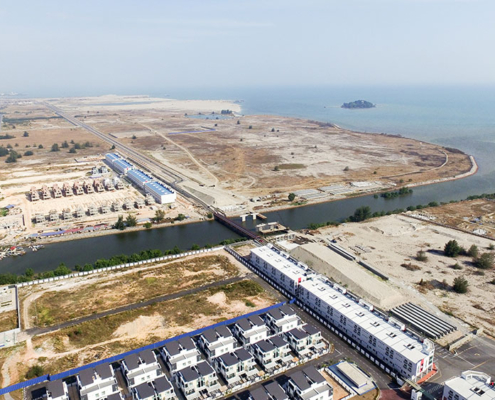Land

Land
What is Land Reclamation
Marina Bay is a bay located in the Central Area of Singapore, surrounded by the perimeter of four other planning areas – the Downtown Core, Marina East, Marina South and Straits View. The area surrounding the bay itself, is a 360 acres extension to the adjacent Central Business District, representing the new downtown of Singapore, and built on fully reclaimed land.
Land reclamation work to create this 360 acres of prime waterfront site began in 1969 and was completed in 1992, forming what is today known as the Marina Centre and Marina South areas, and currently houses the world’s most expensive standalone casino property at S$8 billion (US$6.88 billion), including the land cost.
The result of five years of planning and land reclamation, The Palm Jumeirah lies just off Dubai’s coastline. It forms part of The Palm Islands, along with The Palm, Jebel Ali and The Palm, Deira, the world’s three largest manmade islands. The Palm Jumeirah measures 5km², has created 560 acres of land and has added 78.6km to the country’s 72km coastline.
The Palm Jumeirah was conceived as a natural progression in a succession of extraordinary tourism initiatives in Dubai. It was also an answer to a practical challenge, which was how to create more beachfront when the emirate possessed only 72km of coastline.
The essence of the project is its design – its palm shape, which dictated every step of its development. The choice was both personal and professional. It symbolises Dubai’s heritage (the palm is known as the ‘bride of the orchard’ in Dubai) as well as putting water, the most important source of sustenance, shelter and trade, centre stage. Its shape also provides the perfect geometry to create the longest stretch of new beachfront.
Marina Bay is a bay located in the Central Area of Singapore, surrounded by the perimeter of four other planning areas – the Downtown Core, Marina East, Marina South and Straits View. The area surrounding the bay itself, is a 360 acres extension to the adjacent Central Business District, representing the new downtown of Singapore, and built on fully reclaimed land.
Land reclamation work to create this 360 acres of prime waterfront site began in 1969 and was completed in 1992, forming what is today known as the Marina Centre and Marina South areas, and currently houses the world’s most expensive standalone casino property at S$8 billion (US$6.88 billion), including the land cost.
The result of five years of planning and land reclamation, The Palm Jumeirah lies just off Dubai’s coastline. It forms part of The Palm Islands, along with The Palm, Jebel Ali and The Palm, Deira, the world’s three largest manmade islands. The Palm Jumeirah measures 5km², has created 560 acres of land and has added 78.6km to the country’s 72km coastline.
The Palm Jumeirah was conceived as a natural progression in a succession of extraordinary tourism initiatives in Dubai. It was also an answer to a practical challenge, which was how to create more beachfront when the emirate possessed only 72km of coastline.
The essence of the project is its design – its palm shape, which dictated every step of its development. The choice was both personal and professional. It symbolises Dubai’s heritage (the palm is known as the ‘bride of the orchard’ in Dubai) as well as putting water, the most important source of sustenance, shelter and trade, centre stage. Its shape also provides the perfect geometry to create the longest stretch of new beachfront.